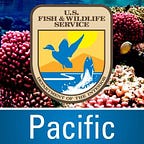Rare, endangered short-tailed albatross chick hatches at Midway Atoll National Wildlife Refuge
A rare, endangered short-tailed albatross chick recently hatched at Midway Atoll National Wildlife Refuge and Battle of Midway National Memorial, within Papahānaumokuākea Marine National Monument. The only nesting pair of short-tailed albatross outside of those nesting on islands south of Japan, each new addition to the species population is important. The pair has raised a chick on Midway Atoll each year since 2019.
The short-tailed albatross pair, affectionately named George and Geraldine, laid their egg on October 28. Since then, biologists have had a trail camera trained on the nest, hoping to catch the first images of the chick hatching. Biologists believe the egg hatched on January 1.
“Short-tailed albatross are spectacular birds and are much larger than the other two species of albatross that nest on Midway Atoll,” said U.S. Fish and Wildlife Service Wildlife Biologist Jon Plissner. “The chicks are much larger as well — and combined with their almost black feathers — really stand out in the sea of Laysan and black-footed albatross chicks.”
With a wingspan of over seven feet, the short-tailed albatross is the largest seabird in the North Pacific. With golden or chocolate brown heads and bright, bubblegum pink bills, they are easily identifiable. From a historic population of millions to less than 10,000 today, the short-tailed albatross is one of most rare and endangered seabirds in the North Pacific. Historically, short-tailed albatross ranged across the Pacific from Japan to Alaska to Hawaii and today, most of their breeding activity is confined to two colonies in the Senkaku Islands and Izu Islands, northwest of Taiwan.
Albatrosses return to Midway Atoll in October and November to reunite with their mates and nest. Most eggs hatch by late December and early January and fledge (grow their adult feathers and head out to sea) by June and July. Albatrosses mate for life and work together to raise their young, taking turns incubating their eggs and caring for and feeding their chick. Because they lay only one egg at time, each chick makes a difference.
Nearly 70% of the world’s mōlī (Laysan albatross) and almost 40% of kaʻupu (black-footed albatross), as well as endangered Short-tailed albatross, all rely on Midway Atoll. In addition to albatross, there are 20 different seabird species that live on Midway Atoll. In total, over three million individual birds call the Refuge and Memorial home.
Biologists with the U.S. Fish and Wildlife Service are working to restore the habitat seabirds need at Midway Atoll and remove threats like invasive predators — because protecting the future for seabirds mean protecting the places they call home.
The U.S. Fish and Wildlife Service works with others to conserve, protect, and enhance fish, wildlife, plants, and their habitats for the continuing benefit of the American people. For more information, visit www.fws.gov/pacificislands, or connect with us through any of these social media channels at https://www.facebook.com/PacificIslandsFWS, www.flickr.com/photos/usfwspacific/, https://medium.com/usfwspacificislands, or www.twitter.com/USFWSPacific.
The U.S. Fish and Wildlife Service works with others to conserve, protect, and enhance fish, wildlife, plants, and their habitats for the continuing benefit of the American people. For more information, connect with us through any of these social media channels at https://www.facebook.com/PacificIslandsFWS, www.flickr.com/photos/usfwspacific/, or www.twitter.com/USFWSPacific.
